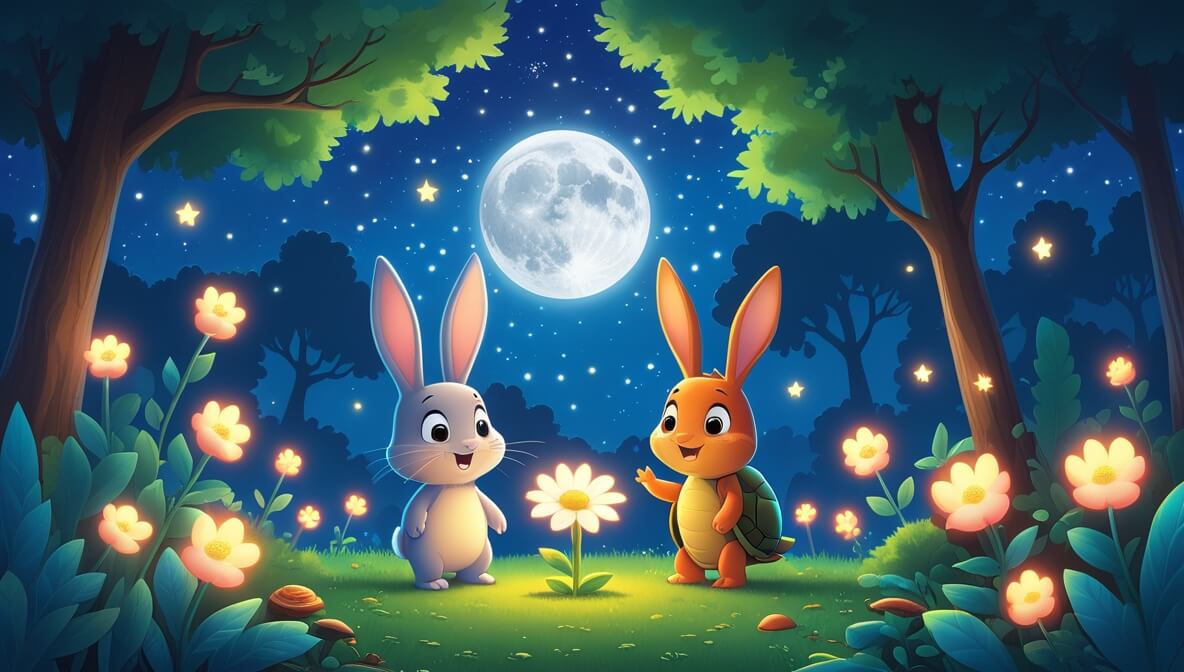A playful bunny and a wise turtle embark on a journey to find the magical moonflower that only blooms under the full moon. Together, they learn about friendship and the wonders of nature.
Age Recommendation
0 – 4 years
Characters
Characters:
- Benny the Bunny (a curious and energetic bunny)
- Tina the Turtle (a thoughtful and wise turtle)
Story
Once upon a time, in a forest filled with tall trees and blooming flowers, lived a playful bunny named Benny. Benny loved to hop around and explore every corner of his home. One sunny morning, he met Tina the Turtle, who was wise and always took her time to enjoy the beauty around her.
The Curious Quest Begins
One day, Benny heard a story about a magical moonflower that only bloomed under the full moon. His eyes sparkled with excitement. “Let’s find the moonflower!” Benny exclaimed to Tina. Tina, with a gentle smile, nodded and said, “Together, we can find anything.”
A Night Under the Stars
As the sun set, Benny and Tina set off on their adventure. They walked through the forest, following the sound of the crickets and the glow of the fireflies. Benny was quick to spot things, while Tina showed him how to listen to the whispers of the night.
The Magical Moonflower
Finally, under the silvery light of the full moon, they found the moonflower. It was more beautiful than they imagined, with petals that shimmered like stars. Benny gently touched the flower, while Tina admired its beauty.
“It’s magical,” whispered Benny. “And we found it together,” Tina replied happily.
The end.
Moral of the Story
This story teaches us about the value of friendship and how working together can help us achieve our goals. It shows the importance of appreciating the beauty of nature and cherishing the moments spent with friends.
Questions to Think About
- Why did Benny want to find the moonflower?
- How did Tina help Benny during their adventure?
- What did Benny and Tina learn from each other?
- Have you ever gone on an adventure with a friend?
- What is your favorite thing about nature?
Do You Know
- The moonflower is a real plant that blooms at night!
- Some animals, like owls and bats, are more active during the night.
Word Explorer
- Magical: Very special and mysterious, like magic.
- Bloom: When a flower opens up and shows its petals.
- Whisper: To speak very softly and quietly.
Emotions in the Story
- Excitement: When Benny heard about the moonflower and wanted to find it.
- Curiosity: When Benny and Tina explored the forest together.
- Happiness: When they finally found the magical moonflower.
Color Your Scene
Imagine the moment when Benny and Tina found the moonflower. Draw the moon shining in the sky, the glowing fireflies, and the magical moonflower with its shimmering petals. Use blue for the night sky and silver for the moonlight.
Parents’ Corner
This story is a wonderful opportunity to talk to your child about:
Friendship: Discuss how Benny and Tina supported each other and why being a good friend is important.
Exploration: Encourage your child to explore nature and find joy in little adventures, just like Benny and Tina.
Appreciating Nature: Help your child notice the beauty around them in everyday life, from flowers to the stars in the night sky.
Teamwork: Highlight how working together can lead to wonderful discoveries.











